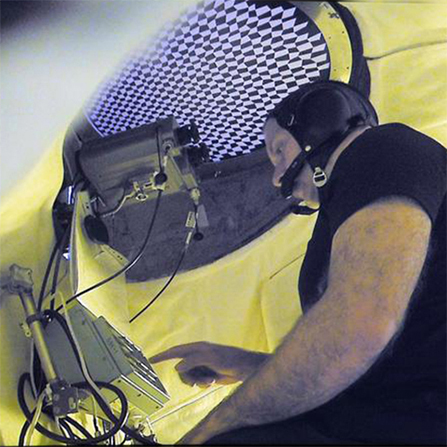
- Simulations
The manned Soyuz spacecraft is equipped with a standard system for determining distance and approach velocity. In the event of a failure of this standard system, a backup system is employed. This backup system relies on a laser distance meter, as it is not possible to accurately estimate distance and approach speed visually.
The objective was to develop a simulator that allows cosmonauts to learn how to effectively use a laser rangefinder.
In the course of the work:
– Modeled the entire alternative process for distance determination using a laser rangefinder;
– Created the necessary devices and software;
– Integrated the development into the Don-Soyuz TMA2 simulator.
For this purpose, a laser rangefinder simulator was created, along with an optical positioning system specifically designed for it. The simulator rotates freely on a standard static ball joint and features three degrees of freedom, which are determined by our positioning system.
The Meter Simulator includes a microdisplay that shows a video image visible through the eyepiece viewfinder. It is connected to computers, allowing it to fully simulate both normal and abnormal behavior.
A camera is mounted on the simulator, and above it, a single large black-and-white marker illuminated by an infrared source is statically positioned. The computing system processes the video stream from the camera and accurately determines the three orientation angles of the moving object, corresponding to the degrees of freedom.
Throughout the course of the work, we achieved the following performance metrics for the positioning system:
– mean square deviation in angle - less than 3’ angular seconds;
– time of positioning data output - less than 50 ms.
-
Client:
Центр подготовки космонавтов им. Ю.А.Гагарина.
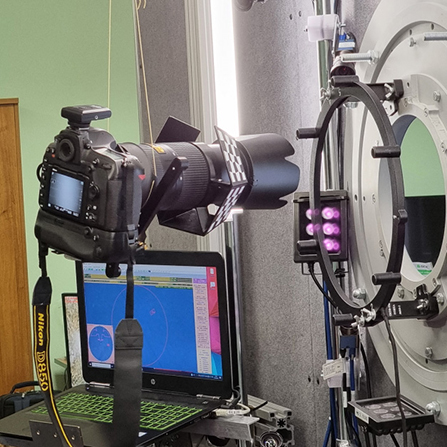
- Simulations
The positioning system was developed during the latest upgrade of the visual-instrumental observation simulator, which is used by cosmonauts to prepare for geophysical research and Earth monitoring from the Russian segment of the International Space Station.
The optical positioning system is developed using video cameras and markers. It determines the location and orientation of a marked object moving within a limited space in real time, controlling all six degrees of freedom of the object.
Black and white markers are placed on the object, while cameras and light sources in both the visible and infrared ranges are positioned statically around the movement zone. The computer processes the video stream from these cameras to determine six coordinates of the position and orientation of the moving object.
During the development, we achieved the following characteristics:
- mean square deviation by angle - less than 1 arc minute,
- mean square deviation by distance - less than 10 µm,
- positioning data output time - less than 50 ms.
Such modernization allows to improve the quality of training and adaptability of astronauts to specific conditions of scientific experiments.
-
Client:
YU. A. Gagarin research & test cosmonaut treining center.
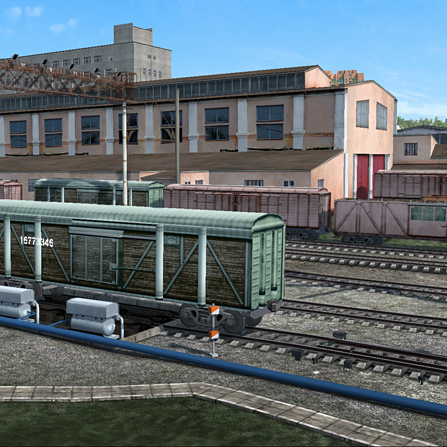
- Simulations
This is a simulator to train hump yard operators, who put together cargo trains.
The visualization system has a very exact virtual model of a train sorting hump, which is rendered on a number of projectors or monitors. Thus a panoramic view is formed, the same as the operator has in reality. All the conditions, different time of day, season, fog and precipitation can be simulated.
A replica of a real control board allows to control virtual semaphores, switches and retarders.
Over the years, more than 15 simulators of this kind, each having exact model of a different respective sorting hump were installed in their respective sites. This includes Ekateringurg, Novosibirsk, St.Petersberg, Khabarovsk, Chelyabinsk and Yaroslavl.
-
Client:
SIBERIAN TRANSPORT UNIVERSITY
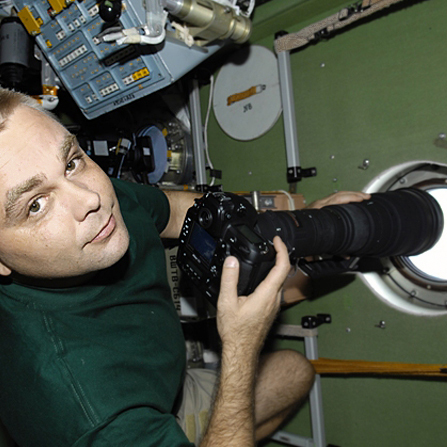
- Simulations
We are developing a simulator-trainer for visual and instrumental observations (VIO) for geo-pysical research and Earth monitoring onboard the Russian segment of the ISS.
With this simulator, the cosmonauts work out skills of locaing and making pictures of Earth objects from the ISS.
-
Client:
YU. A. Gagarin research & test cosmonaut treining center.
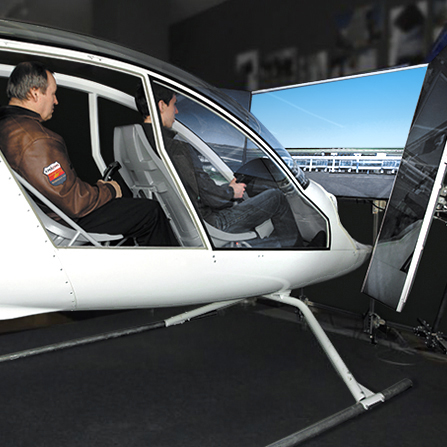
- Simulations
We present COLIBRI flight simulator-trainer.
It is one of the least costly and easy to use simulators, intended for primary pilots training.
It has two versions - Professional and Standard.
The trainer provides a number of general aviation vehicles - planes and helicopters, including R-22, EC-130, Mi-8 and others.
The realistic environment is implemented as aerial imagery overlays plus some 3D buildings. We composed lessons for certain training tasks, in accordance to the methodology of Sergei Piskunov, a pilot and a flight school head, and we also implemented an automated skill assesment system. Emergency situations (engine and other systems failures) can be worked out on the trainer without any limitations. The software enables instantly modifying the flight conditions, weather, geographic location, and stopping the lesson for critical analysis and restaring.
The trainer is cost-efficient, it is 6-8 cheaper (per hour) than a real helicopter and it does not require medical certification.
The COLIBRI Professional consists of:
- a helicopter cabin (Afalina, Heliwhale, Russoa) with flight controls - cyclic, collective and the pedals
- dashoard (a sensor sreeen)
- an instructr sead with duplicated controls
- a computer image generator with three 60" TV panels providing 120 degrees of FOV
The required space is 3x5 meters, can be installed by two persons in 1 day.
The COLIBRI Standard consists of:
- a pilot's seat with flight controls - cyclic, collective and the pedals
- a computer image generator with four 40" TV panels providing 160 degrees of FOV
The required space is 2x2 meters, can be installed by two persons in 1 day.
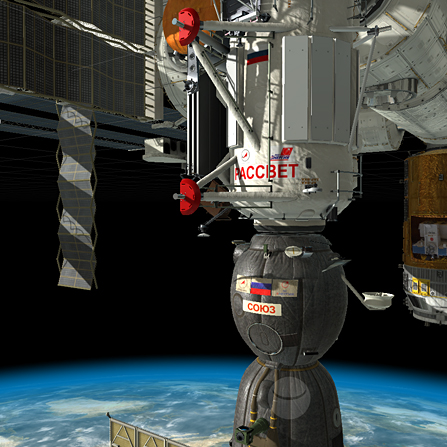
- Simulations
Computer image generator for a simulator of manual docking of a space ship to ISS.
The visualization system uses a detailed 3D model of the ISS. The 3D model is modified to reflect the modifications of the ISS itself. The simulator can be configured for an arbitrary list of modules, docked according to the rules. Thus any ISS configuration required by the training plan can be assembled.
-
Client:
YU. A. Gagarin research & test cosmonaut training center.
